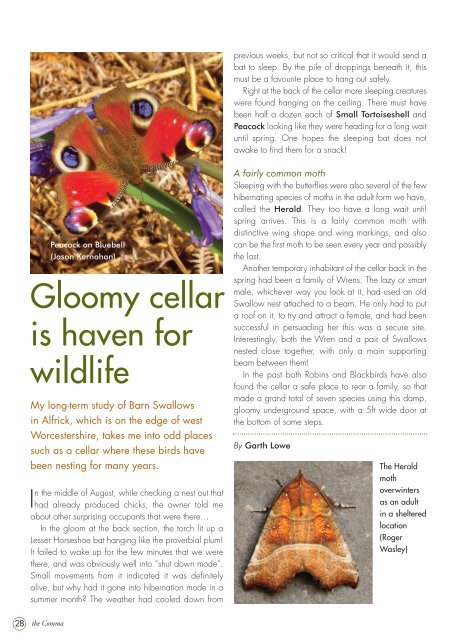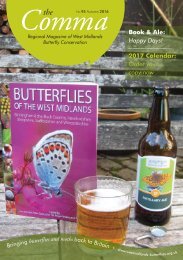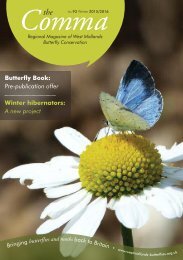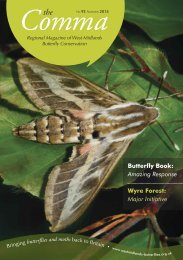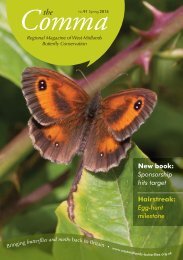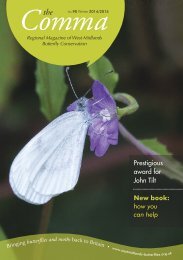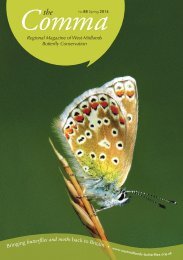Comma-WestMidBC-autumn-2014
Butterfly Magazine for the West Midlands Branch of Butterfly Conservation
Butterfly Magazine for the West Midlands Branch of Butterfly Conservation
You also want an ePaper? Increase the reach of your titles
YUMPU automatically turns print PDFs into web optimized ePapers that Google loves.
previous weeks, but not so critical that it would send a<br />
bat to sleep. By the pile of droppings beneath it, this<br />
must be a favourite place to hang out safely.<br />
Right at the back of the cellar more sleeping creatures<br />
were found hanging on the ceiling. There must have<br />
been half a dozen each of Small Tortoiseshell and<br />
Peacock looking like they were heading for a long wait<br />
until spring. One hopes the sleeping bat does not<br />
awake to find them for a snack!<br />
Peacock on Bluebell<br />
(Jason Kernohan)<br />
Gloomy cellar<br />
is haven for<br />
wildlife<br />
My long-term study of Barn Swallows<br />
in Alfrick, which is on the edge of west<br />
Worcestershire, takes me into odd places<br />
such as a cellar where these birds have<br />
been nesting for many years.<br />
In the middle of August, while checking a nest out that<br />
had already produced chicks, the owner told me<br />
about other surprising occupants that were there…<br />
In the gloom at the back section, the torch lit up a<br />
Lesser Horseshoe bat hanging like the proverbial plum!<br />
It failed to wake up for the few minutes that we were<br />
there, and was obviously well into “shut down mode”.<br />
Small movements from it indicated it was definitely<br />
alive, but why had it gone into hibernation mode in a<br />
summer month? The weather had cooled down from<br />
A fairly common moth<br />
Sleeping with the butterflies were also several of the few<br />
hibernating species of moths in the adult form we have,<br />
called the Herald. They too have a long wait until<br />
spring arrives. This is a fairly common moth with<br />
distinctive wing shape and wing markings, and also<br />
can be the first moth to be seen every year and possibly<br />
the last.<br />
Another temporary inhabitant of the cellar back in the<br />
spring had been a family of Wrens. The lazy or smart<br />
male, whichever way you look at it, had used an old<br />
Swallow nest attached to a beam. He only had to put<br />
a roof on it, to try and attract a female, and had been<br />
successful in persuading her this was a secure site.<br />
Interestingly, both the Wren and a pair of Swallows<br />
nested close together, with only a main supporting<br />
beam between them!<br />
In the past both Robins and Blackbirds have also<br />
found the cellar a safe place to rear a family, so that<br />
made a grand total of seven species using this damp,<br />
gloomy underground space, with a 5ft wide door at<br />
the bottom of some steps.<br />
By Garth Lowe<br />
The Herald<br />
moth<br />
overwinters<br />
as an adult<br />
in a sheltered<br />
location<br />
(Roger<br />
Wasley)<br />
28<br />
the <strong>Comma</strong>


